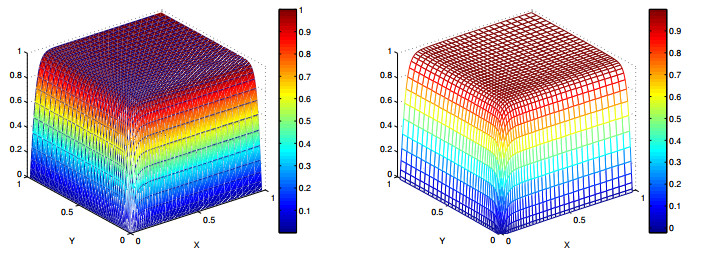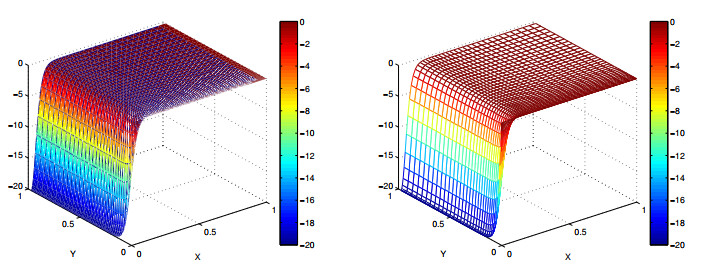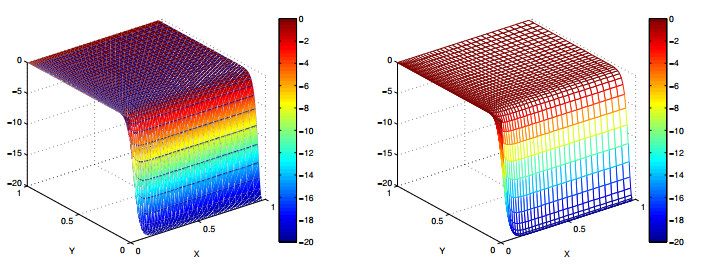1.
Introduction
In this paper, we consider the following time fractional Cattaneo equation:
where Ω=(xL,xR)×(yL,yR), ∂Ω is the boundary, T is the final time, and n is the unit outward normal to ∂Ω. p is the pressure, f(x,y,t), φ(x,y), ψ(x,y) are given known functions, and a=diag(ax(x,y,t),ay(x,y,t)) is a positive definite matrix, i.e., there are two positive constants a∗ and a∗ such that
The Caputo fractional derivative DC0Dαtp is defined by
Equations of this type describe the combined diffusion and wave-like behavior of heat conduction and have been widely used in various fields such as chemistry, biochemistry, thermoelasticity, and fluid mechanics [1,2,3]. More discussions of (1.1)–(1.3) are given in [4,5].
In recent years, many works have been devoted to numerical methods for the fractional Cattaneo equation. For example, a high-order compact finite difference scheme for the generalized fractional Cattaneo equation was proposed in [6], where the Caputo fractional derivative was discretized by the classical L1 formula. Zhao and Sun [7] constructed a compact Crank-Nicolson difference scheme for the one-dimensional fractional Cattaneo equation, where both the integer-order and fractional-order time derivatives were discretized by the Crank-Nicolson scheme. Ren and Gao [8] developed some compact alternating direction implicit difference schemes for the two-dimensional time fractional Cattaneo equation. Wei [9] presented a new finite difference method to approximate the Caputo fractional derivative and then applied it to introduce a fully discrete local discontinuous Galerkin method for the fractional Cattaneo equation. Nikan et al. [10] studied a local meshless method for the time fractional Cattaneo model.
The block-centered finite difference (BCFD) method is a powerful tool in computational fluid dynamics [11,12,13]. The key idea of this method is to approximate the pressure at the cell center, the x-component of velocity at the midpoint of the vertical edges of the cell, and the y-component of velocity at the midpoint of the horizontal edges of the cell. The advantage of the BCFD method is that it can guarantee mass conservation and approximate simultaneously the velocity and pressure with second-order accuracy on non-uniform rectangular grids. Recently, the BCFD method has been applied to solve various fractional partial differential equations, such as the time fractional diffusion equation [14,15,16], time fractional advection-dispersion equation [17], nonlinear fractional cable equation [18], and time fractional diffusion-wave equation [19]. In particular, the BCFD method combined with the Crank-Nicolson scheme for (1.1)–(1.3) was analyzed in [20].
To the best of our knowledge, most of the above methods can only achieve (3−α)-order accuracy in time. Moreover, due to the nonlocal dependence of Caputo fractional derivatives, the above methods require the storage of the solutions at all previous time steps, which leads to large computation time and memory. In order to improve computational efficiency, Yan et al. employed the sum-of-exponentials (SOE) approximation to the kernel function and proposed a fast and second-order FL2−1σ method for the time fractional diffusion equations in [21]. Based on the FL2−1σ formula and a weighted approach, Lyu et al. [22] constructed a fast linearized finite difference scheme for the nonlinear time fractional wave equation. Their scheme can achieve second-order accuracy in time and greatly reduces the computational complexity. Subsequently, Bai et al. [23] presented a fast second-order finite-difference time-domain method for the time fractional Maxwell system. Although there are some results of fast BCFD methods for the fractional diffusion equations [24,25], there are no studies on the fast second-order BCFD method for the fractional Cattaneo equation.
The purpose of this paper is to propose and analyze a fast second-order BCFD method for (1.1)–(1.3). For the spatial discretization, we adopt the BCFD method, and for the time discretization, we apply a proper linear weighted combination of the FL2−1σ formula for the Caputo fractional derivative [22], and establish fitted time approximations for the integer-order terms. Using the special properties of the discrete coefficients and mathematical induction method, we derive the unconditional stability of the proposed method rigorously. Then, by establishing a proper relation between the velocity and the difference of the pressure, we show that the proposed method yields second-order superconvergence in both time and space for the velocity and pressure in discrete L∞(L2)-norms on a non-uniform rectangular grid. Compared with the original BCFD method in [20], our new method is more accurate and efficient.
The structure of the paper is as follows. In Section 2, we first introduce some notation and basic results, and then develop a fast second-order BCFD method for (1.1)–(1.3), where a special approximation is used for the solution at the first time step. In Section 3, we apply the mathematical induction method to establish the stability of the method. The superconvergent error estimate is derived in Section 4. Finally, in Section 5, three numerical examples are presented to support our theoretical results.
Throughout the paper, we use C, with or without subscripts, to denote a generic positive constant, whose value may vary in each occurrence.
2.
The fast second-order BCFD method
To illustrate our fast second-order BCFD method, we introduce the velocity u=(ux,uy)=−a∇p and rewrite (1.1) and (1.2) as
For the time discretization, a proper linear weighted combination of the FL2−1σ formula is applied for the Caputo fractional derivative and fitted time approximations are established for the integer-order terms. Let N be a positive integer, τ=TN<1 be the time step, σ=3−α2, tσ=στ, and tn=nτ,0≤n≤N. For a smooth function p on [0,T], we define pσ=p(tσ) and pn=p(tn). Moreover, we set
The SOE approximation proposed in [21,26] reads as:
Lemma 2.1. Let β=α−1. Then for given tolerance error ε≪1, and final time T, there exist a positive integer Ne, positive quadrature nodes sj, and corresponding positive weights ωj such that
and the number of quadrature nodes needed is of the order
Denote
For n=0, let
For n≥1, let
Denote
where
Then, the weighted combination of the FL2−1σ formula proposed in [22] for the Caputo derivative is:
According to [27,28,29], we have the following lemmas.
Lemma 2.2. Assume that p∈C4[0,T]. Then we have
Lemma 2.3. Assume that p∈C3[0,T]. Then we have
Lemma 2.4. The sequence {˜bn}(n≥1) satisfies
Lemma 2.5. The sequences {g(i+1)0}(0≤i≤n) and {g(n+1)i}(1≤n≤N−1,1≤i≤n) satisfy
Lemma 2.6. Assume that u∈C2[0,T]. Then we have
Lemma 2.7. For any real sequence {Fn}(1≤n≤N−1), when τ and ε are sufficiently small, we have
Lemma 2.8. For integer n≥0, let τ,H and an,bn,cn,dn,γn be non-negative numbers such that
and τγn<1. Then
For the spatial discretization, the BCFD method is considered. Let Nx and Ny be two positive integers. The domain Ω is partitioned by Gx×Gy, where
For 1≤i≤Nx and 1≤j≤Ny, we use the following notations
We assume that Gx×Gy is regular, that is, there exists a positive constant C such that
Define the grid function spaces:
For a function ω(x,y), let ωl,m denote ω(xl,ym), where l may take values i,i+12 for integer i, and m may take values j,j+12 for integer j. Then, we define the differential operators:
For functions ω and ψ, we define the following discrete L2 inner products and norms:
For a vector-valued function u=(ux,uy), we define the discrete L2 norm
For 1≤i≤Nx and 1≤j≤Ny, define
Then according to [11,20], we have the following lemmas.
Lemma 2.9. If p is sufficiently smooth, then it holds that
Lemma 2.10. If p and u are sufficiently smooth, then for 1≤n≤N−1, it holds that
with the following approximate properties:
Lemma 2.11. For (vx,vy)∈Vh and q∈Ph, it holds that
In order to obtain high-order approximations at the first time step, we use the Taylor expansion to get
It follows from Lemmas 2.2 and 2.3 that
which leads to
Define
Then we have
Therefore,
With the above preparations, our fast second-order BCFD method reads as follows: Find Pn∈Ph and Un=(Ux,n,Uy,n)∈Vh such that
with
Here,
3.
Stability of the method
In this section, we study the stability of the method (2.5)–(2.11). The existence and uniqueness of numerical solutions to (2.5)–(2.11) will follow from these stability results.
Taking (Vx,Vy,Qh)∈Vh×Ph, multiplying (2.5) by hikjQij, summing over 1≤i≤Nx,1≤j≤Ny, and using Lemma 2.11, we obtain that for 1≤n≤N−1,
Similarly, for 0≤n≤N−1, it holds that
Theorem 3.1. For sufficiently small τ and ε, the method (2.5)–(2.11) is unconditionally stable with the following estimate:
where
Proof. To prove the theorem, we only need to show that for 1≤n≤N,
where
Now we prove (3.4) by the mathematical induction method. From (2.6)–(2.11), we easily know that (3.4) holds for n=1. Assume that (3.4) holds for 1≤n≤N−1. Then it is sufficient to show that (3.4) also holds for n=N.
A simple computation yields
Thus, choosing Q=˜dtPn+1 in (3.1) gives
Applying Lemma 2.7 yields
Due to (3.2), we can get
It follows then that
Similarly, using (3.3), we can easily obtain
Using the Cauchy-Schwarz inequality, we have
Substituting (3.7)–(3.10) into (3.6), we conclude that
Summing up (3.11) for n from 1 to N−1 and multiplying by τ, we get
Applying Lemma 2.8 to (3.12) gives
By Lemma 2.5, we have
A direct computation shows that
From [22], we know that
and
Using Lemma 2.4, (2.8), and (2.9), we obtain
and
Combining estimates (3.13)–(3.19) yields
On the other hand, using the triangle inequality, we have
Substituting (3.21) into (3.20), we get
Now, we discuss the following two cases:
Case (Ⅰ): ‖PN‖m+‖˜Ux,N−1+σ‖x+‖˜Uy,N−1+σ‖y≤‖PN−1‖m+‖˜Ux,N−2+σ‖x+‖˜Uy,N−2+σ‖y.
(ⅰ) If ‖UN‖TM≤‖UN−1‖TM, then SN≤SN−1, and (3.4) follows directly.
(ⅱ) If ‖UN‖TM≥‖UN−1‖TM, then
From (3.5), we get
and thus (3.4) follows directly.
Case (Ⅱ): ‖PN‖m+‖˜Ux,N−1+σ‖x+‖˜Uy,N−1+σ‖y≥‖PN−1‖m+‖˜Ux,N−2+σ‖x+‖˜Uy,N−2+σ‖y.
In this situation, we have
From (3.22), it follows that
(ⅰ) If ‖UN‖TM≤‖UN−1‖TM, then we have
Subcase (1): SN=‖PN‖m+‖˜Ux,N−1+σ‖x+‖˜Uy,N−1+σ‖y. Then, (3.4) easily follows from (3.23).
Subcase (2): SN=(2σ−1)‖UN‖TM≤(2σ−1)‖UN−1‖TM≤SN−1, which immediately leads to (3.4).
(ⅱ) If ‖UN‖TM≥‖UN−1‖TM, then
From (3.5), we know that
Using (3.23), (3.4) is clarified, and so the proof is finished. □
4.
Superconvergence of the method
In this section, we investigate the superconvergence of the method (2.5)–(2.11).
Let us introduce the error functions:
By (2.4), (2.8)–(2.11), we can easily obtain
Lemma 4.1. Assume that the analytical solution p is sufficiently smooth. Then, it holds that
Proof. Using the Taylor expansion, we have
which, in combination with (2.6) and (2.7), leads to
From (4.1) and (4.2), we then get
and consequently,
Similarly,
We conclude the proof by combining (4.3) and (4.4). □
Using Lemmas 2.2, 2.3, 2.6, 2.9, and (3.1), we easily obtain that for 1≤n≤N−1,
where
and
Using (3.2), (3.3), and Lemmas 2.10 and 4.1, we conclude that for 0≤n≤N,
where
Theorem 4.1. Assume that the analytical solution p is sufficiently smooth. Then for sufficiently small τ and ε, it holds that
Proof. The proof is similar to that of Theorem 3.1. We only need to apply the mathematical induction method to show
where
By (4.1) and Lemma 4.1, we know that (4.10) holds for n=1. Assume that (4.10) holds for 1≤n≤N−1. Then it suffices to prove that (4.10) also holds for n=N.
Taking Q=˜dtξn+1=dt¯ξn in (4.5) leads to
Applying Lemma 2.7 yields
By (4.8), we have
and therefore
Similarly, using (4.9), we can obtain
Substituting (4.13)–(4.15) into (4.12) gives
Summing up (4.16) for n from 1 to N−1 and multiplying by τ, we conclude that
Using Lemma 2.8, one gets
where
Using (4.2) and Lemma 4.1, we have
Using (4.7) and Lemma 2.5, we obtain
Using (3.16), (3.17), (4.1), and (4.6), we get
By Lemma 2.10, we have
Substituting (4.18)–(4.22) into (4.17), we obtain
Similar to the proof of Theorem 3.1, we can conclude that
Again, we discuss the following two cases:
Case (Ⅰ): ‖ξN‖m+‖˜ηx,N−1+σ‖x+‖˜ηy,N−1+σ‖y≤‖ξN−1‖m+‖˜ηx,N−2+σ‖x+‖˜ηy,N−2+σ‖y.
In this case, we can obtain SN≤SN−1, and (4.10) follows directly.
Case (Ⅱ): ‖ξN‖m+‖˜ηx,N−1+σ‖x+‖˜ηy,N−1+σ‖y≥‖ξN−1‖m+‖˜ηx,N−2+σ‖x+‖˜ηy,N−2+σ‖y.
We use (4.23) to obtain
Following similar arguments as in Theorem 3.1, we can get
By combining (4.24) and (4.25), we obtain (4.10), which completes the proof. □
Theorem 4.2. Assume that the analytical solution p is sufficiently smooth. Then for sufficiently small τ and ε, it holds that
Proof. The proof follows from the triangle inequality, the estimation of δ, and Theorem 4.1. □
Remark 4.1. Theorem 4.2 shows that our method has the second-order temporal accuracy, regardless of the order of the Caputo fractional derivative. It is noteworthy that instead of presenting error estimates for the velocity in discrete L2(L2)-norm [20], we provide rigorous error estimates for the velocity in discrete L∞(L2)-norm. Moreover, the application of the SOE approach reduces storage and computational cost. Thus, our method is more accurate and efficient than the original BCFD method in [20].
5.
Numerical experiments
In this section, we provide four numerical examples to verify our theoretical results. The first three examples are chosen to demonstrate the accuracy and efficiency of the proposed method for smooth solutions, and the fourth example is chosen to demonstrate the performance of the proposed method for solutions with sharp boundary layers. These examples are taken from [20,30] with slight modifications. In all experiments, we choose Ω=(0,1)×(0,1),T=1,ax=ay=1,ε=10−9, and use the Fast-BCFD method and CN-BCFD method to denote our fast second-order BCFD method (2.5)–(2.11) and the Crank-Nicolson BCFD method proposed in [20].
Example 5.1. The initial condition and the right side are chosen according to the exact solution
Example 5.2. The initial condition and the right side are chosen according to the exact solution
Example 5.3. The initial condition and the right side are chosen according to the exact solution
Example 5.4. The initial condition and the right side are chosen according to the exact solution
To compare the accuracy of the Fast-BCFD method and the CN-BCFD method, we take Nx=Ny=N and compute the solutions on three consecutive meshes with N=40,80,160. The errors and convergent rates for Examples 5.1–5.3 with different α are shown in Tables 1–3, respectively. These numerical results show that the convergence rates of the velocity and pressure in discrete L∞(L2)-norms are all around 2 for the Fast-BCFD method, and are all around 3−α for the CN-BCFD method. Clearly, the Fast-BCFD method is more accurate than the CN-BCFD method when α tends to 2.
To compare the computational efficiency of the Fast-BCFD method and CN-BCFD method, we compare the CPU time in seconds of both methods. Since the results for different α are very similar, we only present the results for α=1.5 for brevity. From Table 4, one can check that for small time steps, the Fast-BCFD method is more efficient than the CN-BCFD method.
For Example 5.4, the exact solution exhibits a sharp layer at x=0 and y=0. In order to obtain better accuracy, we adopt the following mesh function:
Numerical results for this example with α=1.9 are summarized in Table 5. Obviously, it can be seen that numerical results using a non-uniform grid are also in agreement with our theoretical analysis. Figures 1–3 depict the graphs of the exact solutions and the numerical solutions computed by the Fast-BCFD method at time T=1 on the non-uniform 40×40 mesh when α=1.9. For a better comparison, Figure 4 shows the computed pressure profiles along y=x, ux-velocity profiles along y=0.5, and uy-velocity profiles along x=0.5. One can observe that our numerical solutions are in good agreement with the exact solutions.
6.
Conclusions
In this paper, a fast second-order BCFD method based on the FL2-1σ formula and a weighted approach was presented for the two-dimensional time fractional Cattaneo equation. The corresponding stability and superconvergence analysis on non-uniform rectangular grids were obtained. The accuracy and efficiency of the proposed method were shown by four numerical examples.
Use of Generative-AI tools declaration
The author declares he has not used Artificial Intelligence (AI) tools in the creation of this article.
Acknowledgments
This work was supported by the Natural Science Foundation of Ningxia (No. 2023AAC03002).
Conflict of interest
The author declares no conflicts of interest.









 DownLoad:
DownLoad:







